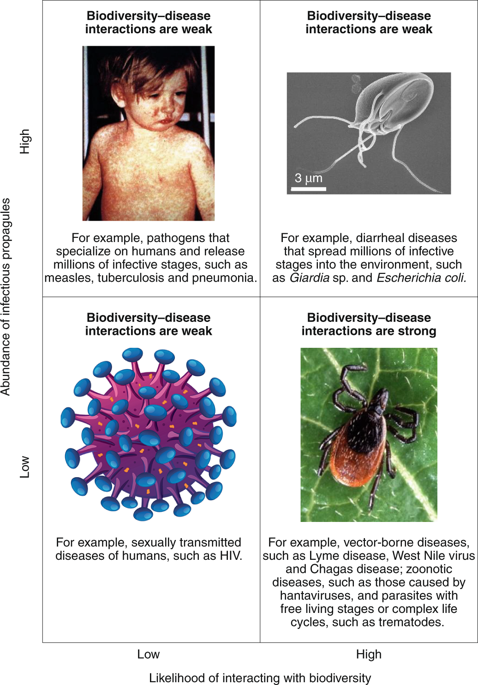当前位置:
X-MOL 学术
›
Nat. Ecol. Evol.
›
论文详情
Our official English website, www.x-mol.net, welcomes your
feedback! (Note: you will need to create a separate account there.)
Towards common ground in the biodiversity-disease debate.
Nature Ecology & Evolution ( IF 13.9 ) Pub Date : 2019-12-09 , DOI: 10.1038/s41559-019-1060-6 Jason R Rohr 1 , David J Civitello 2 , Fletcher W Halliday 3 , Peter J Hudson 4 , Kevin D Lafferty 5 , Chelsea L Wood 6 , Erin A Mordecai 7
Nature Ecology & Evolution ( IF 13.9 ) Pub Date : 2019-12-09 , DOI: 10.1038/s41559-019-1060-6 Jason R Rohr 1 , David J Civitello 2 , Fletcher W Halliday 3 , Peter J Hudson 4 , Kevin D Lafferty 5 , Chelsea L Wood 6 , Erin A Mordecai 7
Affiliation

|
The disease ecology community has struggled to come to consensus on whether biodiversity reduces or increases infectious disease risk, a question that directly affects policy decisions for biodiversity conservation and public health. Here, we summarize the primary points of contention regarding biodiversity-disease relationships and suggest that vector-borne, generalist wildlife and zoonotic pathogens are the types of parasites most likely to be affected by changes to biodiversity. One synthesis on this topic revealed a positive correlation between biodiversity and human disease burden across countries, but as biodiversity changed over time within these countries, this correlation became weaker and more variable. Another synthesis-a meta-analysis of generally smaller-scale experimental and field studies-revealed a negative correlation between biodiversity and infectious diseases (a dilution effect) in various host taxa. These results raise the question of whether biodiversity-disease relationships are more negative at smaller spatial scales. If so, biodiversity conservation at the appropriate scales might prevent wildlife and zoonotic diseases from increasing in prevalence or becoming problematic (general proactive approaches). Further, protecting natural areas from human incursion should reduce zoonotic disease spillover. By contrast, for some infectious diseases, managing particular species or habitats and targeted biomedical approaches (targeted reactive approaches) might outperform biodiversity conservation as a tool for disease control. Importantly, biodiversity conservation and management need to be considered alongside other disease management options. These suggested guiding principles should provide common ground that can enhance scientific and policy clarity for those interested in simultaneously improving wildlife and human health.
中文翻译:

在生物多样性疾病辩论中达成共识。
疾病生态学界一直在努力就生物多样性是否会降低或增加传染病风险达成共识,这一问题直接影响生物多样性保护和公共卫生的政策决策。在这里,我们总结了关于生物多样性与疾病关系的主要争论点,并建议媒介传播的、多面性的野生动物和人畜共患病病原体是最有可能受到生物多样性变化影响的寄生虫类型。关于这一主题的一项综合表明,各国之间的生物多样性与人类疾病负担之间存在正相关关系,但随着这些国家的生物多样性随着时间的推移而发生变化,这种相关性变得更弱且变化更大。另一项综合——对一般较小规模的实验和实地研究的荟萃分析——揭示了各种宿主分类群中生物多样性与传染病(稀释效应)之间的负相关。这些结果提出了一个问题,即生物多样性与疾病的关系是否在较小的空间尺度上更为负面。如果是这样,适当规模的生物多样性保护可能会防止野生动物和人畜共患病的流行或成为问题(一般积极的方法)。此外,保护自然区域免受人类入侵应该可以减少人畜共患病的蔓延。相比之下,对于某些传染病,管理特定物种或栖息地和有针对性的生物医学方法(有针对性的反应性方法)可能优于生物多样性保护作为疾病控制的工具。重要的,生物多样性保护和管理需要与其他疾病管理选择一起考虑。这些建议的指导原则应提供共同基础,以提高那些对同时改善野生动物和人类健康感兴趣的人的科学和政策清晰度。
更新日期:2019-12-11
中文翻译:

在生物多样性疾病辩论中达成共识。
疾病生态学界一直在努力就生物多样性是否会降低或增加传染病风险达成共识,这一问题直接影响生物多样性保护和公共卫生的政策决策。在这里,我们总结了关于生物多样性与疾病关系的主要争论点,并建议媒介传播的、多面性的野生动物和人畜共患病病原体是最有可能受到生物多样性变化影响的寄生虫类型。关于这一主题的一项综合表明,各国之间的生物多样性与人类疾病负担之间存在正相关关系,但随着这些国家的生物多样性随着时间的推移而发生变化,这种相关性变得更弱且变化更大。另一项综合——对一般较小规模的实验和实地研究的荟萃分析——揭示了各种宿主分类群中生物多样性与传染病(稀释效应)之间的负相关。这些结果提出了一个问题,即生物多样性与疾病的关系是否在较小的空间尺度上更为负面。如果是这样,适当规模的生物多样性保护可能会防止野生动物和人畜共患病的流行或成为问题(一般积极的方法)。此外,保护自然区域免受人类入侵应该可以减少人畜共患病的蔓延。相比之下,对于某些传染病,管理特定物种或栖息地和有针对性的生物医学方法(有针对性的反应性方法)可能优于生物多样性保护作为疾病控制的工具。重要的,生物多样性保护和管理需要与其他疾病管理选择一起考虑。这些建议的指导原则应提供共同基础,以提高那些对同时改善野生动物和人类健康感兴趣的人的科学和政策清晰度。











































 京公网安备 11010802027423号
京公网安备 11010802027423号